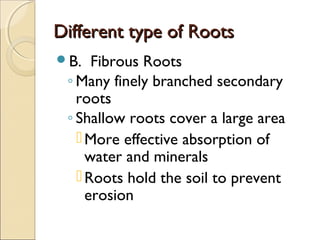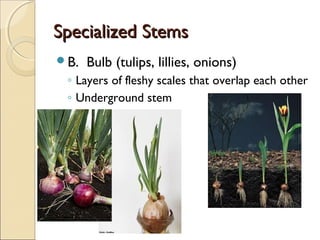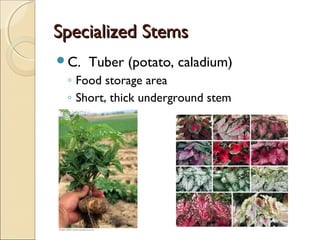Plant parts
- 1. Basic Parts of the Plant Roots Stems Leaves Flower
- 2. Leaves 1. Make food through photosynthesis 2. Provide site of gas exchange 3. Store food
- 3. Roots 1. Anchor Plant 2. Absorb water and minerals 3. Translocate water and minerals to stem 4. Store Food
- 4. 2 main types of Roots
- 5. Different type of Roots A. Tap Root ◦ Continuation of the primary root ◦ Ideal for anchorage ◦ Penetration is greater for water ◦ Storage area for food made by photosynthesis
- 6. Different type of Roots B. Fibrous Roots ◦ Many finely branched secondary roots ◦ Shallow roots cover a large area More effective absorption of water and minerals Roots hold the soil to prevent erosion
- 7. Roots Root hairs: ◦ Tiny one celled hair like extensions of the epidermal cells located near the tips of the roots where vascular tissues have formed. ◦ Increase surface area ◦ Absorb water and minerals from soil
- 8. Stems 1. Translocate water, minerals and food to the leaves 2. Support the leaves and display them to light 3. Store Food
- 9. Specialized Stems B. Bulb (tulips, lillies, onions) ◦ Layers of fleshy scales that overlap each other ◦ Underground stem
- 10. Specialized Stems C. Tuber (potato, caladium) ◦ Food storage area ◦ Short, thick underground stem
- 12. Flowers 1. Contain organs for specialized sexual production 2. Produce seeds and fruit
- 13. Parts of the Flower Sepals ◦ Outer covering of the flower bud ◦ Protects the stamens and pistils when flower is in bud stage
- 14. Parts of the Flower Petals ◦ Brightly colored ◦ Protects stamen and pistils ◦ Attracts pollinating insects
- 15. Parts of the Flower Stamens ◦ Male Reproductive part ◦ Anther-produces pollen ◦ Filament-supports the anther
- 16. Parts of the Flower Pistil ◦ Female reproductive part ◦ Ovary Enlarged portion at base of pistil Produces ovules which develop into seeds ◦ Stigma Holds the pollen grains
- 17. Parts of the Flower Style ◦ Connects the stigma with ovary ◦ Supports the stigma so that it can be pollinated
- 18. Complete and Incomplete Flowers Complete: have all four main parts ◦ Sepals ◦ Petals ◦ Stamens ◦ Pistils

















